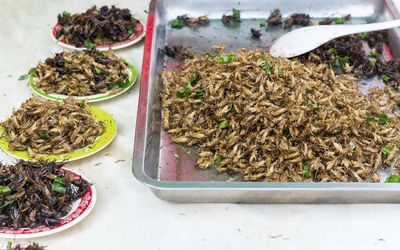IMAGINE eating a cricket. Does the crunch of an exoskeleton and a warm burst of guts come to mind? Exo wants you to think of Michelin stars. The Brooklyn, US-based start-up has closed a $4m funding round to bring chef-created cricket-flour foods to the masses. Investors include AccelFoods, the Collaborative Fund, and the rapper Nas.
The company, which sells health bars online and at Whole Foods and Wegman’s in the US, plans to use the money to boost its retail presence.
It is also working to launch new products based on cricket flour, such as ready-to-drink shakes and protein powders, to help appeal to fitness buffs — especially cross-fitters and paleo-diehards who help make up the company’s core market — and consumers who avoid eating meat for ethical or health reasons.
"In the long term, we envision cricket powder being competitive with soy, and whey, and any other protein source," says Exo co-founder Greg Sewitz. "That starts with introducing cricket protein to a consumer base with no direct experience with it and a lot of preconceived ideas that were negative."
FOR THAT, they’ve turned to Kyle Connaughton, who is something of a food-world star and has been developing palate-tempting recipes for Exo’s cricket-flour protein bars for the past three years.
In 2013, before Exo had sold a single bar, a mutual friend introduced the chef to Sewitz and fellow cricket evangelist co-founder Gabi Lewis.
Armed with a United Nations report on eating insects, they argued that compared with beef, poultry, and other animal proteins, cricket farming produces far more protein per litre of water or kilogram of feed. Citing a passage from Leviticus, they claimed crickets should be considered kosher. (Although ironically, crickets may trigger crustacean shellfish allergies.)
Connaughton needed no cricket conversion. In 2009, he and Heston Blumenthal teamed up to createan entomological dish for British television show Heston’s Feasts.
THEY injected a tomato sauce into the bellies of fried crickets. "It had a great fried crunch and delicious liquid centre that really challenged people," Connaughton says.
His role in this sustainable protein partnership is arguably the linchpin:to help people become comfortable with the idea of entomophagy — aka insect-eating, which 80% of the world does, according to some estimates — and to make the company’s products tasty enough that people who try one come back for seconds.
The first challenge, he says, was getting into the mind-set of people who eat protein bars. "From a chef’s perspective, I’m around food all day," Connaughton says, "so trying to supplement food with a protein bar isn’t that much part of my lifestyle."
Cooking with cricket flour turns out to be relatively straightforward. Wheat flour, for instance, contains gluten that helps produce a chewy texture — while making faddish consumers shudder. Exo’s cricket flour has what Connaughton calls a "low culinary function", meaning it doesn’t do much on a structural level.
Instead, nut butters are used as a base and binder, although more than half the protein in the bars— about 10g, depending on the recipe — still comes from crickets. There are about 40 bugs in every bar.
Roasting crickets at high temperatures is the fastest way to make flour,but that process can impart a strong taste and aroma. Instead, Exo freezes, then dehydrates the bugsin a multistep process that resultsinneutral-tasting powder.
The company is also experimenting with other techniques to affect the taste and function of cricket flour, Sewitz says.
The insects are small enough that feeding them a steady diet of carrots, say, or apple can change the taste and colour of the cricket flour.
For now, Exo’s crickets are raised on organic grains and filtered water and sourced from farms in the US and Canada thathave cropped up to supply an increased demand for insects raised for human consumption.
SPECIALITY producers such asEntomo Farms, in Norwood, Ontario, and All Things Bugs, in Athens, Georgia, are milling insect flours for Exo and competitors. Salt Lake City’s Chapul sells bars, and Portland, Oregon-based Cricket Flours has products thatinclude cake mix.
"We looked at the development of these bars the way a chef looks at creating a new restaurant dish," Connaughton says.
That meant using nut butters instead of the brown rice syrups that many energy bar makers rely on, as well as eschewing clichéd flavour analogues, such as brownies or cookie dough, and taking chances on such savoury concepts such asmango curry and barbecue.
For a Mediterranean-styled bar marketed as a salve for "all your ultimate umami cravings", Connaughton tested 15 types of sun-dried tomatoes and various techniques for blanching olives.
After nailing the flavour on a small scale, Connaughton’s development kitchen at Pilot R+D took on the gruelling process of adapting the recipe for mass production and a particular set of nutritional guidelines. Eight months and dozens of recipes later, they had a final formula incorporating almonds, tahini, sea salt, and sesame seeds, and a price of about $3.50 a bar.
Despite the real ingredients and top chef, a health bar is still a bar. Restaurant critic Tejal Rao thinks the Mediterranean bar is "weird and malty"; Exo’s cocoa nut bar tastes "healthy, in a lean, punitive" way; and the blueberry-vanilla has a "paleo Fig Newton thing going on", but "barbecue flavour is best".
Bloomberg



















Change: 0.40%
Change: 0.47%
Change: -0.49%
Change: 0.53%
Change: 1.03%
Data supplied by Profile Data
Change: 1.71%
Change: 1.13%
Change: 0.40%
Change: 0.00%
Change: 1.37%
Data supplied by Profile Data
Change: -1.06%
Change: -0.24%
Change: -1.13%
Change: -1.33%
Change: 0.81%
Data supplied by Profile Data
Change: -1.02%
Change: -1.12%
Change: 0.13%
Change: 1.93%
Change: 0.52%
Data supplied by Profile Data